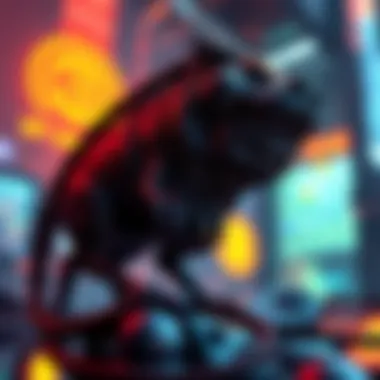Understanding NFTs: Their Role in Cryptocurrency


Intro
In the whirlwind of digital finance, few topics stir as much curiosity and debate as Non-Fungible Tokens (NFTs). As the world shifts toward a more digitalized economy, NFTs have emerged as a cornerstone of the cryptocurrency landscape. Their unique characteristics set them apart from traditional digital currencies like Bitcoin or Ethereum, where each unit is interchangeable. Instead, NFTs offer individualized ownership of digital assets, which has sparked interest across a variety of sectors, notably in art, gaming, and intellectual property.
This article takes a closer look at the intricate world of NFTs, beginning with the foundational aspects of cryptocurrency and blockchain technology. By unraveling the complexities involved, we aim to equip readers, whether they are seasoned investors or curious newcomers, with a rich understanding of this innovative digital phenomenon. Let’s embark on this journey to explore what makes NFTs tick, the broader implications for the market, and how they may reshape various industries in the future.
Cryptocurrency Basics
Understanding Blockchain Technology
At the heart of NFTs lies blockchain technology. Unlike traditional databases that are controlled by a central authority, a blockchain operates as a decentralized ledger. Each block of transactions is linked to a previous one, creating a secure chain. This ensures transparency and makes it nearly impossible to alter any information without consensus from multiple participants on the network.
In simpler terms, think of blockchain as a public library where anyone can access books. Once a book is in the library, it can’t be replaced without consensus from the librarian and patrons. In the case of NFTs, this technology allows for clear proof of ownership. When you purchase an NFT, what you’re essentially obtaining is a unique digital certificate that verifies your ownership within this global library.
Key Concepts in Cryptocurrency
To truly grasp NFTs, it's essential to outline some key concepts within the cryptocurrency ecosystem:
- Fungibility: Cryptocurrencies like Bitcoin are fungible; each unit is identical and interchangeable. NFTs are non-fungible and unique, making each one a singular item.
- Smart Contracts: These are self-executing contracts with the terms of the agreement directly written into code on the blockchain. They facilitate automatic transactions, enhancing the functionality of NFTs.
- Wallets: To buy, sell, or hold NFTs, you need a digital wallet. There are various kinds of wallets, each offering different levels of security and accessibility.
By understanding these concepts, investors can better navigate the intricate waters of NFTs. Knowledge is power, especially in a field as dynamic as cryptocurrency.
"In the world of cryptocurrency, understanding the underlying technology is as crucial as knowing the market trends."
As we move forward, our investigation will touch on investment strategies, exploring risk management techniques and diversification in crypto portfolios. This knowledge is critical for those looking to engage meaningfully with NFTs and the broader cryptocurrency market.
Prelims to Non-Fungible Tokens
The realm of digital assets has seen a groundbreaking development with the introduction of Non-Fungible Tokens (NFTs). Unlike traditional currencies or assets that can be exchanged on a one-to-one basis, NFTs are unique. This uniqueness sets them apart and allows them to hold specific value based on their distinct characteristics.
Understanding NFTs is pivotal in today's cryptocurrency landscape because they bridge the gap between digital ownership and the burgeoning virtual economy. The rise of NFTs transforms how artists, gamers, and collectors interact with their favorite platforms and communities. This shift not only democratizes the art market but also provides creators an opportunity to monetize their work directly, without intermediaries that typically dictate terms.
Importance of Non-Fungible Tokens
NFTs are significant for several reasons:
- Ownership Verification: Each NFT is minted on a blockchain, ensuring that ownership is easily verifiable and tamper-proof. This aspect appeals to artists who want to affirm their rights over their creations.
- Engagement with Content: Artists and content creators can engage with their audiences in innovative ways. Fans can own a piece of work, participating in a community rather than just being passive viewers.
- Investment Potential: As industries like fine art and virtual real estate awaken to the possibilities of NFTs, many see them as investment opportunities. Some NFTs have sold for staggering amounts, attracting investors eager to capitalize on their worth.
It’s also worth noting that the landscape is not without its complications. The NFT market's rapid expansion brings challenges, including issues of copyright, volatility in value, and the environmental impact of blockchain technology. Thus, a thorough understanding of NFTs is essential for anyone looking to navigate this intricate world.
Key Takeaway: NFTs redefine ownership in the digital domain, allowing for new business models and artistic expressions.
By delving into the fundamentals of NFTs, this article aims to equip readers with insights and understanding, ensuring they are well-prepared to engage with this innovative segment of the cryptocurrency ecosystem.
Defining NFTs
In the world of cryptocurrency, non-fungible tokens (NFTs) have created quite a stir. At their core, these tokens are unique digital assets that hold specific values, unlike their fungible counterparts such as Bitcoin or Ethereum, which are interchangeable. Therefore, understanding NFTs is crucial if you want to grasp how this emerging technology is reshaping various industries, from art and gaming to virtual real estate.
NFTs offer distinct advantages. Firstly, they provide provenance and ownership verification for digital assets, enforcing the idea that a digital item can be owned just like any physical piece of art. This characteristic draws interest from creators and collectors. Furthermore, the ability to create scarcity in a digital environment adds another layer of value, allowing artists and creators to monetize their work in ways that were previously unfeasible. However, it comes with its share of considerations, such as market volatility and intellectual property rights.
Characteristics of Non-Fungibility
Non-fungibility implies distinctiveness and individuality. Unlike dollars or gold, which can be exchanged on a one-for-one basis, an NFT represents a unique unit that is not interchangeable with any other unit. Each NFT contains information that defines its uniqueness — think of it like a snowflake; no two are alike.
- Unique Identification: Every NFT carries a unique identifier and metadata that distinguishes it from every other token.
- Tangible Ownership: Ownership is recorded on the blockchain, making it easily verifiable.
- Indivisibility: NFTs cannot be divided into smaller units. If you own an NFT, you own the whole token, not just a piece of it.
These characteristics set NFTs apart within the cryptocurrency landscape, emphasizing their utility in establishing ownership and authenticity in the digital realm.
Difference Between Fungible and Non-Fungible Tokens
To fully appreciate the role of NFTs, it is essential to draw a line between fungible and non-fungible tokens. Here’s a clearer breakdown:
- Fungible Tokens: These tokens are identical in value and can be exchanged freely. For instance, one Bitcoin can be exchanged for another Bitcoin since they hold equivalent values.
- Non-Fungible Tokens: In contrast, one NFT cannot easily be swapped for another on a one-to-one basis. Each token holds its unique value based on its specific attributes and metadata.
To illustrate further, imagine you have a rare baseball card. This card is not interchangeable with another standard card of the same sport; its value is influenced by factors like historical context, condition, and rarity. In the NFT context, this parallels the value derived from an artist's original digital painting versus a replicated version. This unique property is what makes NFTs a compelling asset class within the broader cryptocurrency ecosystem.
"NFTs redefine ownership and value in digital assets, enabling a new form of rights management and creativity in the online space."


Thus, delineating NFTs provides a strong foundation for understanding their implications, advantages, and challenges within today’s rapidly evolving digital landscape.
For additional insights, consider exploring resources on Wikipedia, or Britannica.
Historical Context of NFTs
Understanding the historical context of Non-Fungible Tokens (NFTs) is essential for grasping their significance in the cryptocurrency landscape. By tracing the journey of NFTs from their inception to their current status in popular culture, one can discern the shifts in technological, economic, and artistic paradigms. This context lays the groundwork for appreciating the innovations they bring and informs potential investors and enthusiasts about the evolving dynamics of digital assets.
NFTs didn't emerge out of a vacuum. Instead, they represent a natural progression within the broader environment of cryptocurrencies and blockchain technology. From modest beginnings as experimental digital collectibles to a booming market with multi-million dollar sales, the trajectory of NFTs tells a story about creativity, ownership, and market speculation.
The following subsections explore key milestones and cultural shifts in the history of NFTs, illuminating their development and reflecting on the opportunities and challenges that accompany their rise.
Early Examples in Cryptocurrency
When considering the origins of NFTs, one must start with early experiments in blockchain-based assets. In 2012, Colored Coins introduced the notion of representing real-world assets on a blockchain. While it was a rudimentary concept, Colored Coins set the stage for more sophisticated digital tokens. It allowed for the creation of tokens that carried specific information beyond the transaction data traditionally captured by cryptocurrencies.
Subsequently, in 2017, CryptoKitties made waves in the digital landscape. It was more than just a blockchain game – it verified ownership of unique virtual cats using Ethereum's blockchain technology.
- Key features of CryptoKitties include:
- Ownership verification via smart contracts
- Individual attributes for each digital cat that affect its value
- The novelty factor that attracted a diverse range of players, from developers to casual gamers
Due to its unexpected popularity, CryptoKitties not only showcased the potential of NFTs but also highlighted issues of scalability on the Ethereum network. Many activities became congested, revealing the inherent challenges of blockchain technology when applied to an NFT marketplace. Surprisingly, this initial experience set the stage for further advancements.
The Rise of NFTs in Popular Culture
The ascent of NFTs into mainstream consciousness is a narrative woven through cultural icons and significant events. With the burgeoning interest in NFTs, artists began exploring how this technology could transform their practices. In 2021, the digital artist Beeple sold a collage of his work as an NFT for a staggering price of $69 million at Christie's auction house. This sale catapulted NFTs into the spotlight, attracting attention not just from tech enthusiasts but also from traditional art collectors.
In addition to fine art, NFTs found a foothold in music, sports, and cinema, allowing creators across various industries to monetize their work in novel ways. For instance, artists like Grimes and Kings of Leon launched NFT collections, tapping into a market hungry for unique digital experiences.
Notably, the integration of NFTs into social media platforms, such as Twitter and Instagram, brought about new pathways for sharing and trading digital assets, effectively democratizing access to this realm.
- Factors driving the popularity of NFTs in culture include:
- A desire for ownership of unique digital assets
- The blending of art and technology, resonating with younger generations
- The appeal of investment opportunities alongside creative expression
As NFTs continued to evolve, so did public perception, which shifted from skepticism to a more nuanced understanding of their value and utility. The increasing convergence of the digital and physical worlds led many to consider NFTs not just as collectibles but as integral parts of cultural identity.
Technical Foundations of NFTs
The technical framework that supports Non-Fungible Tokens (NFTs) is as crucial as the diverse applications they inspire. At the core, the interaction of blockchain technology and smart contracts forms the backbone of these digital assets. Understanding this foundation can provide significant insights into how NFTs function, their benefits, and the considerations to keep in mind while engaging with them.
Blockchain Technology Underpinning NFTs
Blockchain technology serves as the public ledger that makes NFTs possible. It ensures transparency, immutability, and security. Each NFT exists on a blockchain, which acts like a digital record book where details about each token are securely stored. This way, once an NFT is created, its ownership history and authenticity become traceable, helping to combat fraud and counterfeit products.
The most widely used blockchain for NFTs is Ethereum, famed for its robust infrastructure that supports the ERC-721 and ERC-1155 standards specifically designed for non-fungible assets. However, other blockchains like Binance Smart Chain and Flow have emerged, offering alternative environments where NFTs can flourish.
Key benefits of utilizing blockchain technology for NFTs include:
- Decentralization: No single entity controls the NFT, meaning ownership is fully in the hands of the owner.
- Security: Cryptographic principles prevent tampering.
- Transferability: Seamless transferring of ownership without needing intermediaries, which reduces costs.
When examining the mechanics, it’s evident that blockchain is not just a trendy buzzword but a foundational technology that enables the unique aspects of NFTs to be realized.
"Blockchain creates trust in a decentralized environment, making it indispensable in the realm of digital ownership."
Smart Contracts and Their Role
Smart contracts are self-executing contracts where the terms of the agreement are written directly into code. They are pivotal for the functionality of NFTs. Essentially, these contracts automate processes, eliminating the need for intermediaries and reducing the risk of errors or disputes.
In the context of NFTs, smart contracts govern the creation, transfer, and ownership verification of tokens. They can stipulate rules such as royalties for artists upon resale, ensuring creators continue to benefit from their work, even after initial sale. This is a notable shift from traditional markets, where artists often see very little from secondary sales.
The role of smart contracts in NFTs can be summarized as follows:
- Automation: They execute predefined actions when certain conditions are met, like transferring ownership upon payment.
- Customization: Developers can customize contracts to include features like royalties or other specifications.
- Transparency: Transactions conducted through smart contracts are recorded on the blockchain, promoting trust and accountability.
The integration of smart contracts with NFTs not only enhances functionality but also opens up new avenues for creativity and business models in the digital asset space. This interplay between technology and artistry is where the future potential of NFTs truly lies.
For further reading, consider visiting Wikipedia on Blockchain, which provides a comprehensive overview of how this technology underpins various applications, and Ethereum for Creators for those interested in diving deeper into smart contract development.


NFT Marketplaces
In the realm of non-fungible tokens, marketplaces serve as the bustling hubs for digital commerce. They play a pivotal role in facilitating the buying, selling, and trading of NFTs, bridging the gap between creators, collectors, and investors. This section unpacks the various elements that define NFT marketplaces, their advantages, and key considerations for anyone looking to navigate this vibrant ecosystem.
Popular Platforms for Buying and Selling NFTs
Several platforms stand out in the NFT marketplace arena, providing a smorgasbord of options for users with varying tastes and budgets. Some of the most notable include:
- OpenSea: Often regarded as the kingpin of NFT marketplaces, OpenSea boasts a colossal selection of digital assets. Here, artists can mint NFTs with ease, and collectors can browse through millions of listings, encompassing everything from digital art to virtual real estate.
- Rarible: Rarible is about community governance. It allows artists to not only sell their creations but also gives users a say in the platform's future through token-based voting. This fosters a sense of ownership among users, a rarity in many marketplaces.
- Foundation: More exclusive than others, Foundation focuses on high-quality art. Creators usually need an invitation to join, which helps maintain a certain level of artistic integrity. This curation draws serious collectors in search of something truly unique.
- Zora: Zora positions itself as a decentralized marketplace, catering to creators first and foremost. By allowing artists to establish their own terms, Zora emphasizes the relationships between creators and collectors, making the experience more personal.
These platforms make it relatively straightforward for first-time users. With simple interfaces, engaging layouts, and robust community support, dipping one’s toes into the world of NFTs has never been easier. However, potential buyers should educate themselves about the various fees associated with each platform, which can sometimes catch newcomers off guard.
Risks Associated with NFT Transactions
While entering the NFT bazaar can seem like a golden opportunity, one should tread carefully. Like any asset, there are risks that accompany transactions in these marketplaces. Some considerations include:
- Market Volatility: Just like stocks, NFT prices can swing dramatically within short periods. An art piece bought for a hefty sum today might not hold its value tomorrow, especially if it’s a speculative purchase rather than a beloved collectible. The volatility can create anxiety for investors looking to resell at a profit.
- Fraud and Scams: The anonymity that blockchain affords can sometimes attract unscrupulous actors. Fakes and unauthorized reproductions of original works can flood the market. Always verify the legitimacy of the NFT and the seller before making any purchase.
- Gas Fees: Transactions on blockchain networks typically incur 'gas fees', a cost that can fluctuate dramatically depending on network traffic. At times, these fees can surpass the cost of the NFT itself, leading to surprising expenses for the naïve buyer.
- Intellectual Property Issues: The ownership of an NFT does not necessarily confer rights to the underlying intellectual property. Buyers should clarify what rights (if any) they acquire upon purchase. Not understanding this distinction can lead to legal entanglements down the line.
"Investing in NFTs isn’t for the faint of heart; newcomers should arm themselves with knowledge to avoid common pitfalls."
In a nutshell, while NFT marketplaces present exciting opportunities, they’re not without risks. Awareness and due diligence can go a long way toward making informed decisions in this ever-evolving landscape. Collectors, traders, and casual enthusiasts should weigh potential gains against these risks judiciously, ensuring their journey into the world of NFTs is both fruitful and enjoyable.
Applications of NFTs
Non-Fungible Tokens (NFTs) have carved out a distinctive niche in the cryptocurrency realm, expanding their applications across various domains. Understanding these applications is crucial, as they underscore the significance of NFTs beyond mere speculation in the market. From digital art to gaming assets, NFTs are shaping new paradigms in ownership, creativity, and monetization, thus reshaping how industries function. Here, we will explore several key areas where NFTs have made a substantial impact.
NFTs in Art and Collectibles
NFTs have revolutionized the art world by allowing artists to tokenize their work, creating a new way to authenticate and sell art. When an artist mints an NFT, they create a unique digital certificate that proves ownership and authenticity. This has opened doors for independent artists, giving them direct access to collectors without the need for galleries or agents.
One notable example is Beeple, a digital artist who sold an NFT for $69 million at a Christie's auction, showcasing how NFTs can merge traditional auction dynamics with digital creativity. Some benefits of NFTs in art include:
- Ownership Transparency: Each NFT is recorded on a blockchain, making the ownership history transparent and verifiable.
- Royalties for Artists: Smart contracts can ensure that artists receive a percentage of sales whenever their work is resold, providing ongoing revenue streams.
- Digital Scarcity: Artists can create limited editions of their works, making them more desirable to collectors.
Despite these advantages, challenges exist, such as copyright issues where the distinction between ownership of the NFT and ownership of the digital art is often murky.
Gaming and Virtual Assets
In the gaming industry, NFTs are changing how players view ownership and trade. Players can truly own their in-game assets, such as skins, weapons, and characters, in contrast to traditional gaming models where items remain the property of the game developers.
Games like Axie Infinity and Decentraland have popularized NFTs, where players can buy, sell, and trade unique items, blurring the lines between gaming and investment. Key aspects of NFTs in gaming include:
- Interoperability: NFTs can often be used across multiple games, allowing players to transfer assets from one platform to another.
- Enhanced Player Engagement: The ability to buy, trade, and sell encourages deeper investment in games.
- Economic Incentive Models: Players can earn income by participating in games and trading their NFTs, creating a new economic ecosystem.
Though promising, the gaming sector also faces hurdles like high transaction fees and concerns about regulatory frameworks as the market continues to evolve.
NFTs in Intellectual Property and Licensing
Intellectual property (IP) is another sphere where NFTs are making waves. They provide a new framework for managing and monetizing IP rights for creators and businesses. By tokenizing intellectual property as NFTs, rights holders can establish clearer ownership and licensing agreements. This is particularly beneficial in industries like music and publishing.
Some critical attributes include:
- Simplified Licensing: NFTs can enable automatic licensing agreements through smart contracts, streamlining the process for creators and consumers.
- Proof of Ownership: Tokenizing IP provides undeniable proof of ownership that can be easily transferred, reducing the risk of unauthorized use.
- Market Access: NFT platforms can provide expanded market access to creators, allowing them to reach global audiences without intermediaries.
Nonetheless, legal challenges related to IP rights and the evolving nature of NFT regulations may complicate this growth.
The applications of NFTs go beyond simple transactions. They are reshaping industries, creating new markets, and redefining ownership in the digital age.
As we continue to see advancements in technology and society's understanding of digital ownership, it's likely that the applications of NFTs will expand even further, inviting investors, artists, and businesses to reconsider how they interact with digital assets.
Legal and Ethical Considerations
In the rapidly evolving world of NFTs, the legal and ethical framework is essential. As digital assets gain traction, understanding the implications of ownership, transaction rights, and legal protections becomes increasingly important. For investors, artists, and creators alike, knowing these aspects helps navigate this complex landscape.
Copyright Issues Surrounding NFTs
When it comes to NFTs, one of the most pressing issues is copyright. Each NFT is unique, representing ownership of a specific digital asset, yet it does not automatically grant copyright to the buyer. This distinction can lead to significant misunderstandings. For instance, an NFT might depict a piece of art, but purchasing the NFT does not mean the buyer can reproduce or distribute it commercially; those rights typically remain with the original creator.


This brings us to the heart of the matter: who retains the rights? Often, artists will clarify through contracts what rights are transferred when an NFT is sold. Many creators choose to embed licensing terms directly in the smart contracts that accompany their NFTs; however, gaps in understanding can still exist. It’s crucial for buyers to do their due diligence—to have a read more in-depth than just skimming over the surface—to grasp what they are actually obtaining. Misunderstanding copyright can lead to legal disputes, making clear communication paramount.
"Owning an NFT is akin to owning an original painting, but that doesn’t mean you own the rights to replicate it."
Consumer Rights and Protection
As with any marketplace, consumer rights are critical in the world of NFTs. The challenge lies in the fact that, currently, the legal protections for consumers engaging with this digital frontier are somewhat nebulous. Many traditional laws have not yet adapted to the specificities of digital assets, which can leave buyers vulnerable.
Consumers should be aware of the following factors when purchasing NFTs:
- Transparency: Smart contracts should be clear about the terms of purchase, including what rights or limitations come with the NFT.
- Fraud Risks: With the anonymity that cryptocurrency provides, scams can occur. It’s important to buy from reputable marketplaces and verify the authenticity of the NFTs.
- Resale: The resale of NFTs raises questions too. If a buyer decides to sell their NFT, do they retain any rights to royalties from that sale, or does that right revert back to the original creator?
Understanding these elements allows consumers to make more informed choices and look out for their own interests in a market that can occasionally feel like the Wild West.
Ultimately, as legislation continues to catch up with technological advancements, the legal and ethical considerations surrounding NFTs will have to be scrutinized closely. Artists, creators, consumers, and investors need to stay informed to navigate the murky waters and ensure fair practices for all involved.
Challenges in the NFT Space
As the NFT market continues to gain traction, this section addresses critical challenges that accompany the rise of Non-Fungible Tokens. Understanding these obstacles is fundamental for investors, collectors, and enthusiasts who navigate this intricate landscape. While many view NFTs as revolutionary assets, it's essential to dissect the underlying complexities and consider their implications.
Market Volatility and Speculation
The NFT market is famously unpredictable. One day, a digital artwork might be selling for millions, and the next, its price could plummet, leaving investors scratching their heads. This market volatility can often be traced back to the fervor of speculation. In essence, speculation occurs when traders buy assets not for their intrinsic value but to sell them at higher prices later.
- Rapid Price Fluctuations: NFTs can experience insane price swings, sometimes within hours. This fluctuation can be attributed to trends on social media, endorsements by celebrities, or just plain hype. It's a game of musical chairs — once the music stops, only the ones left holding the bag are left wondering. This behavior can deter more serious investors looking for stability.
- Collector Psychology: The emotional aspect of collecting NFTs often leads to irrational spending. Many collectors may overlook fundamental analysis in favor of joining the latest trend, driven by the fear of missing out. This can create an artificial inflation of prices that may not reflect the true value of the assets.
- Weighing Gains Against Risks: Investors need to ask themselves if the potential returns are worth the risks of engaging in a market that can swing on a dime. Awareness and proper research are vital to navigating the choppy waters.
"The NFT market operates on perception; today’s high value can be tomorrow’s regret."
Environmental Concerns About Blockchain
A growing conversation surrounding NFTs involves their environmental impact. Many NFTs are produced on platforms such as Ethereum, which, until recently, used a proof-of-work (PoW) mechanism requiring vast amounts of electricity. This has led to widespread criticism from environmentalists who argue that the carbon footprint associated with this energy-intensive process is unsustainable.
- Energy Consumption: While exact figures can vary, it’s estimated that a single Ethereum transaction can consume energy equivalent to the average electricity use of a household for several days. Such high consumption raises eyebrows, especially when considering the global push towards sustainability.
- Transition to Sustainable Practices: The industry is taking steps towards greener solutions, especially with Ethereum's transition to proof-of-stake (PoS), which significantly lowers energy demands. Although positive, the question remains whether all stakeholders in the NFT space will embrace these changes or continue to prioritize profit over planet.
- Public Perception and Regulations: Increasing awareness of these issues is prompting regulatory bodies to take action. Potential regulations concerning environmental impact could shape the future of NFT markets. Artists and creators in the space must pay attention, as the ethics of production not only affect the environment but also their personal brands.
In summary, while NFTs boast potential benefits, they also come with challenges that require cautious navigation. Both the market volatility and the environmental concerns serve as stark reminders that innovation often carries weighty responsibilities.
The Future of NFTs
The trajectory of Non-Fungible Tokens (NFTs) seems to be one of the most exhilarating narratives in the ever-evolving landscape of cryptocurrency. With their capacity to transform numerous industries, from art to gaming and beyond, understanding the future of NFTs is indeed paramount. The potential benefits that these digital assets may bring, along with the accompanying considerations, are vital not just for enthusiasts but also for investors and traders looking to position themselves wisely.
Emerging Trends and Innovations
The world of NFTs is hardly static. As technology progresses and societal attitudes shift, the trends surrounding NFTs are also changing at a breakneck pace. One promising trend is the rise of fractional ownership, allowing more people to participate in high-value NFT markets. Instead of needing a hefty sum to buy a whole piece of digital art, individuals can purchase fractional shares of an NFT, making it more accessible.
Moreover, innovations in royalty structures are increasingly coming to the forefront. This essentially means that artists and creators can earn a percentage every time their NFT is sold or resold. This ongoing income stream vastly shifts the traditional dynamics of art sales, providing sustainability for creators.
On a larger scale, integration with augmented reality (AR) and virtual reality (VR) is poised to change the consumer experience. Imagine viewing an NFT art piece in your living room through AR or attending a virtual concert where NFT tickets grant you exclusive access to meet-and-greet sessions. Such imaginative uses are not just hypothetical but are beginning to take form.
"In the coming years, NFTs will likely evolve to include additional certifications, enhancing their value and appeal as collectibles and investments."
Integration with Other Technologies
Another critical aspect to note is how NFTs are gearing up to merge with various technologies. Artificial intelligence (AI) is one such area. With the ability to analyze data, AI could help in validating the authenticity of NFTs or even creating generative art that can be minted as NFTs. This intersection between technology and creativity could redefine artistry in the digital age.
Additionally, blockchain interoperability is a growing concern. Currently, most NFTs are confined to the blockchain where they are minted. Future advancements could enable tokens to travel across different blockchains, allowing for greater liquidity and utility. Think of it as a global passport for NFTs, elevating their usability across various platforms.
Lastly, regulatory frameworks are gradually taking shape. Various countries are starting to establish guidelines for the NFT marketplace, aiming to safeguard both creators and consumers. Clear regulations will not only help in legitimizing this sphere but also in attracting institutional investors who have previously been cautious.
In summation, the future of NFTs encompasses a rich tapestry of emerging trends and significant technological integrations that promise to further enhance their utility and viability. As we gaze into the horizon, staying informed about these shifts will surely be an asset for investors, traders, and anyone keen on navigating the intricate ecosystem of NFTs.
Epilogue
In the expansive realm of cryptocurrency, the conclusion regarding Non-Fungible Tokens (NFTs) encapsulates not just the culmination of insights presented throughout the article, but also serves as a pivotal reflection on their significance in our digital era. NFTs have fundamentally altered the landscape of ownership and value in the digital realm, carving out a niche that goes beyond mere speculation.
First and foremost, it is critical to recognize that NFTs manifest the true potential of blockchain technology. By providing a mechanism for unique digital representation, they challenge traditional notions of ownership and authenticity. This transformation can be particularly seen in industries such as art, where artists can directly connect with their audience, thus eliminating intermediaries and allowing for new revenue streams.
Moreover, the intrinsic nature of NFTs fosters a richer, more engaging experience for creators and collectors alike. They allow for a diverse range of applications, from gaming assets to virtual real estate, showing how versatile this technology can be. This, in turn, can lead to innovations in various sectors, instigating new business models and enhancing consumer engagement.
Yet, it’s important to approach the NFT market with a degree of caution. The volatility and unpredictability associated with these tokens pose risks, particularly for uninformed investors. Having a clear understanding of the market dynamics, legal implications, and ethical considerations surrounding NFTs is essential. Without such awareness, one could easily find themselves on the wrong side of a transaction.
The journey through this realm not only broadens our comprehension of digital ownership but also compels us to think critically about the implications of these advancements. As we stand at the brink of this evolution, it is the responsibility of investors, enthusiasts, and scholars alike to navigate this space with insight and understanding, laying the groundwork for a sustainable and equitable digital economy.
"NFTs are not just a fleeting trend; they are the beginning of a new digital paradigm."
For further reading on NFTs and their impact, resources like Wikipedia and Britannica provide comprehensive insights.



